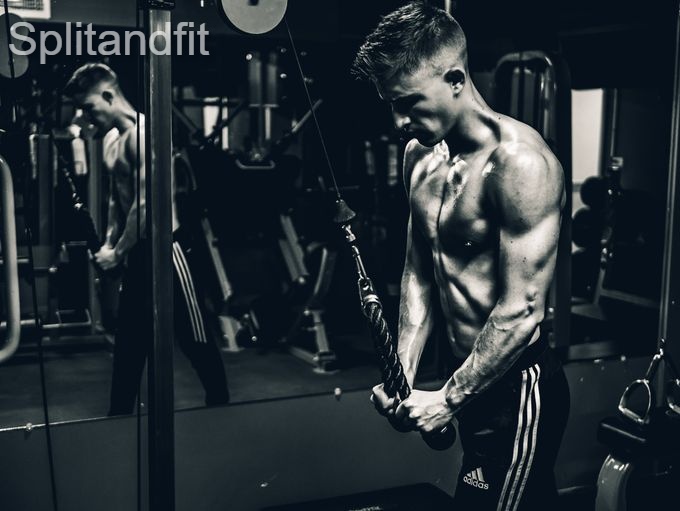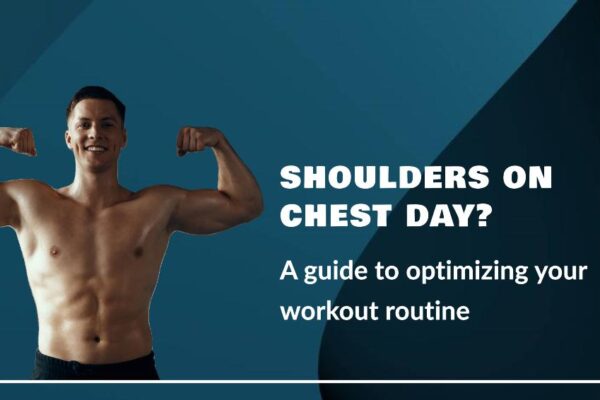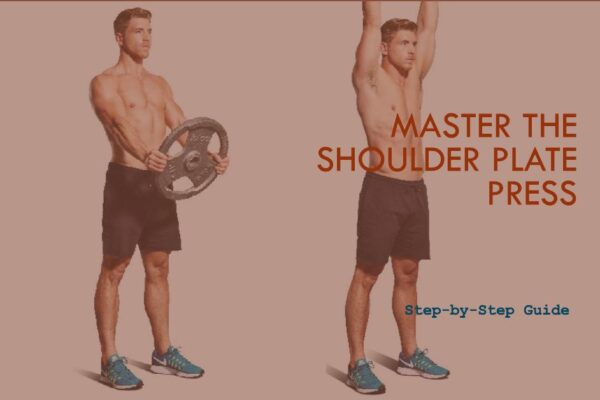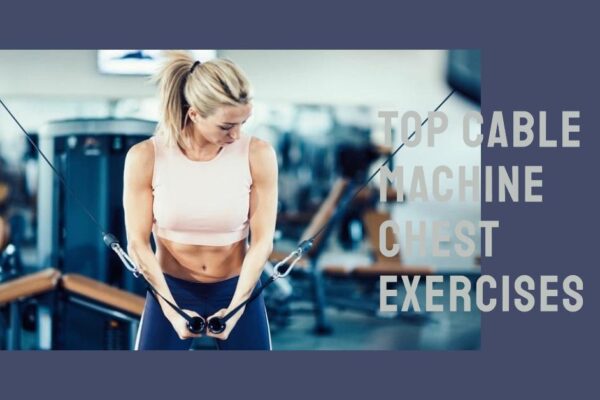The debate over whether to train shoulders on the same day as chest workouts has been a topic of discussion among fitness enthusiasts and experts. Should I Do Shoulders On Chest Day? would set the stage for the discussion by highlighting the significance of both shoulder and chest training in achieving overall upper-body strength and aesthetics.
It would also address the potential benefits and drawbacks of integrating shoulder workouts with chest routines, providing an overview of the key points elaborated in the content. This introduction aims to pique the reader’s interest and set the tone for an informative and balanced exploration of the topic.
Should I Do Shoulders On Chest Day?
Yes, it is okay to train shoulders before chest day. Training shoulders first can be beneficial as it allows you to focus on proper form and maximal effort during your shoulder workout. Additionally, pre-fatiguing the shoulders may improve overall chest engagement during the subsequent chest workout. However, it’s important to listen to your body and adjust your training based on individual recovery ability to prevent overtraining and injury.

Should you train chest and shoulders on the same day?
The question of whether to train shoulders on the same day as chest workouts is a topic that garners diverse opinions within the fitness community. Some advocate for training both muscle groups together to enhance overall upper body strength and stability, thereby supporting heavier lifts and more challenging exercises. Others caution against potential drawbacks, such as decreased performance in the muscles trained on the second day, emphasizing the need for strategic planning and recovery.
The debate also involves considerations of how shoulder engagement impacts chest exercises and vice versa, adding another layer of complexity to the decision-making process. These perspectives from various fitness resources underscore the importance of a well-informed approach when addressing the question of training chest and shoulders on the same day.
Why Should I Do the Shoulders and Chest Together?
Here are some reasons why you might consider training shoulders and chest together:
- Muscle Synergies: Combining shoulder and chest exercises can take advantage of the natural synergies between these muscle groups, potentially leading to more efficient workouts and maximizing the use of overlapping muscle activation.
- Time Efficiency: Training shoulders and chest together can help optimize workout time by focusing on multiple upper body muscle groups in a single session, allowing for greater overall efficiency in the training regimen.
- Functional Movement Patterns: Some exercises that involve both the chest and shoulders mimic functional movement patterns, which can be beneficial for athletes and individuals seeking to improve overall strength and coordination.
- Convenience: For individuals with limited time for workouts, combining shoulder and chest exercises can provide a comprehensive upper-body workout in a single session, making it a convenient option for busy schedules.
- Variety and Challenge: Incorporating a variety of exercises for the chest and shoulders in the same workout can add diversity to the routine, potentially providing a new challenge and preventing monotony in the training program.
These reasons highlight the potential benefits of integrating shoulder and chest workouts into a single session, offering a well-rounded approach to upper body training.
What muscles Does a Chest and Shoulder workout Use?
Muscles Targeted by Shoulder Workouts:
- Deltoids: Shoulder workouts primarily engage the deltoid muscles, which consist of the anterior (front), lateral (side), and posterior (rear) heads. These muscles are responsible for various shoulder movements, including shoulder abduction, flexion, and extension.
- Trapezius: Shoulder exercises often involve the trapezius muscles, particularly during movements that require scapular retraction and elevation, contributing to shoulder stability and upper back strength.
Muscles Targeted by Chest Workouts:
- Pectoralis Major: Chest workouts predominantly target the pectoralis major muscles, which are responsible for movements such as horizontal adduction and internal rotation of the shoulder joint, commonly known as the pressing and fly movements.
- Triceps: Many chest exercises also engage the triceps, as they act as synergistic muscles during pressing movements, contributing to elbow extension and overall upper-body pushing strength.
Understanding the specific muscles targeted by each type of workout is crucial for designing a comprehensive training regimen and ensuring balanced muscle development.
The Importance of Shoulder Training
Shoulder training is crucial for enhancing overall upper body strength and aesthetics. It goes beyond mere aesthetic benefits; it plays a vital role in posture enhancement and strengthening the muscles surrounding the shoulder joint, thus creating a more stable foundation for upper body movements.
Benefits of Integrating Shoulder Workouts with the Chest Routine
- Enhanced Upper Body Strength: Integrating shoulder workouts with the chest routine allows for comprehensive upper body strength development. Strengthening the shoulders enables individuals to perform challenging exercises and lift heavier weights during chest workouts, contributing to greater muscular endurance and functional fitness.
- Improved Aesthetics: Comprehensive shoulder training complements chest workouts, leading to a balanced and aesthetically pleasing physique. Well-developed shoulders contribute to a symmetrical and proportional upper body appearance, enhancing overall aesthetics and physique symmetry.
- Joint Stability and Injury Prevention: Engaging shoulder muscles during workouts bolsters joint stability, particularly in the shoulder complex. This helps prevent injuries and supports a safe and effective workout regimen by reinforcing the structural integrity of the upper body.
- Functional Support for Daily Activities: Strong shoulder muscles play a crucial role in supporting everyday activities such as lifting, pushing, and pulling. Integrating shoulder workouts with chest routines can improve functional strength, thereby enhancing the performance of daily tasks and activities.
- Balanced Development: By incorporating shoulder exercises into the chest routine, individuals can achieve a more balanced and comprehensive approach to upper body training. This balanced development is essential for reducing the risk of muscular imbalances and promoting overall physical well-being.
Potential Drawbacks of Training Shoulders on Chest Day
- Fatigue and Overtraining: Combining shoulder and chest exercises on the same day may lead to excessive fatigue in the shoulder muscles, potentially compromising the quality of the workout and increasing the risk of overtraining.
- Compromised Performance: Training shoulders after an intense chest workout might impact the performance of shoulder-specific exercises, potentially leading to decreased strength and endurance during shoulder-focused movements.
- Risk of Injury: Performing heavy pressing movements for the chest and then engaging in shoulder exercises could increase the risk of overuse injuries or strain on the shoulder joints and surrounding muscles.
- Inadequate Recovery: Insufficient recovery time for the shoulder muscles between chest and shoulder workouts may hinder optimal muscle recovery and growth, potentially impeding progress and increasing the likelihood of overuse injuries.
- Imbalanced Focus: Focusing on both chest and shoulders during the same workout might result in inadequate attention to each muscle group, potentially hindering the ability to achieve optimal muscle hypertrophy and strength development in both areas.
These potential drawbacks underscore the need to carefully consider the implications of training shoulders on chest day and the importance of structuring workouts in a way that promotes both effectiveness and safety.
Tips for Structuring Your Shoulder and Chest Workout Routine on the Same Day
If you’re considering combining shoulder and chest workouts into the same session, it’s essential to approach it strategically to maximize effectiveness and minimize the risk of fatigue or injury. By structuring your routine thoughtfully, you can ensure that each muscle group receives adequate attention and stimulation. Here are some tips for structuring your shoulder and chest workout routine on the same day:
Warm-Up: Begin with a dynamic warm-up to prepare the shoulders and chest for the upcoming workout. Incorporate arm swings, shoulder rotations, and light chest stretches to increase blood flow and mobility.
Exercise Sequence:
- Compound Movements First: Start with compound exercises that engage both the chest and shoulders, such as barbell bench press, incline bench press, or push-ups. These movements recruit multiple muscle groups and provide a strong foundation for the workout.
- Isolation Exercises: Follow up with isolation exercises specific to the shoulders and chest, such as lateral raises for shoulders and dumbbell flyes for the chest. Isolation exercises can target individual muscles more directly and help with refining muscle definition.
- Superset Chest and Shoulder Exercises: Consider incorporating supersets, alternating between chest and shoulder exercises without rest in between. For example, perform a set of chest presses followed immediately by a set of shoulder presses. This technique can enhance workout efficiency and elevate intensity.
Volume and Intensity: Pay attention to the total volume (sets and reps) and the intensity of the workout. Balancing the workload for both muscle groups is crucial to avoid overtraining and promote balanced development.
Rest and Recovery: Allow adequate rest periods between sets and exercises to promote recovery and maintain performance throughout the workout. Listen to your body’s signals and adjust rest times accordingly.
Cool Down and Stretching: Conclude the workout with a cooldown period and stretching to aid in muscle recovery and flexibility. Focus on stretches that target the chest, shoulders, and upper back to alleviate tension.
By structuring your shoulder and chest workout routine with these considerations in mind, you can optimize training efficiency, promote balanced muscle development, and minimize the risk of overexertion.
Chest and Shoulders Workout Plan
Here’s a complete chest and shoulders workout plan structured:
Week 1-2:
Day 1: Chest and Shoulders
- Exercise 1 – Barbell Bench Press:
- 4 sets x 6-8 reps
- Rest 1-2 minutes between sets
- Exercise 2 – Seated Dumbbell Shoulder Press:
- 4 sets x 8-10 reps
- Rest 1-2 minutes between sets
- Exercise 3 – Incline Dumbbell Flyes:
- 3 sets x 10-12 reps
- Rest 1 minute between sets
- Exercise 4 – Lateral Raises:
- 3 sets x 12-15 reps
- Rest 1 minute between sets
Day 3: Chest and Shoulder Giant Sets
- Perform giant sets, moving from one exercise to the next without rest, for 3 rounds:
- Single-Arm Dumbbell Bench Press:
- 3 sets x 8-10 reps per arm
- Standing Dumbbell Shoulder Press:
- 3 sets x 10-12 reps
- Chest Dips:
- 3 sets to failure
- Front Plate Raise:
- 3 sets x 12-15 reps
- Single-Arm Dumbbell Bench Press:
Week 3-4:
Day 1: Machine-Based Chest Workouts
- Utilize a pec-training program incorporating various machine moves to target the chest effectively. Aim for 4 sets of 8-10 reps for each exercise.
Day 3: Dumbbell Workout Plan at Home
- Perform a home dumbbell workout incorporating exercises targeting the chest, back, and shoulders using dumbbells. Aim for 3-4 sets of 10-12 reps for each exercise.
Additional Tips:
- Gradually increase the intensity and volume of the workouts throughout the month.
- Ensure proper form and technique for each exercise to minimize the risk of injury and maximize effectiveness.
- Maintain a balanced diet and sufficient rest to support muscle recovery and growth.
This comprehensive workout plan is designed to provide a balanced and progressive approach to training the chest and shoulders over the course of a month, incorporating varied exercises and workout structures for optimal development.
Frequent Question Answers
| Question | Answer |
|---|---|
| Should you do chest day or shoulder day first? | It’s advantageous to start with chest exercises before moving on to shoulders. This sequence allows for optimal energy allocation and performance during both muscle group workouts. |
| What day should I do shoulders? | Shoulder workouts can be scheduled based on individual preference, but it’s beneficial to avoid consecutive days of intense shoulder training to allow for proper recovery and minimize the risk of overuse injuries. |
| Can I do chest back and shoulders on the same day? | While it’s feasible to train chest, back, and shoulders in a single workout, it’s essential to distribute the workload evenly across the muscle groups and prioritize exercise sequencing to prevent overexertion. |
| Which muscles should not be trained together? | Larger muscle groups, such as chest and shoulders, should not be trained together immediately before smaller muscle groups, like triceps. This sequencing can compromise performance and lead to suboptimal results. |
| What happens if I skip chest? | Skipping chest workouts could result in imbalanced muscle development and hinder overall upper body strength and aesthetics. Consistent chest training is crucial for a well-rounded upper-body workout routine. |
| Is shoulder muscle bigger than chest? | The deltoids, comprising the shoulder muscles, are relatively smaller compared to the pectoral muscles (chest). Both muscle groups play distinct roles in upper body movement and stability. |
| What gym split should I do? | A popular gym split involves dedicating separate workout days to specific muscle groups, such as chest and triceps, back and biceps, legs, shoulders, and incorporating rest days for recovery and adaptation. |
| Which muscles should I train together? | Combining complementary muscle groups, such as chest and triceps, and back and biceps, in the same workout session can enhance workout efficiency and optimize muscle synergy. |
| What muscles can be worked every day? | It’s generally advised to avoid training the same muscle group intensively every day to allow for adequate recovery. However, light, low-impact exercises targeting various muscle groups can be done daily. |
Conclusion
It’s generally beneficial to prioritize chest exercises before shoulders on the same workout day. Starting with chest workouts can optimize energy allocation and performance during shoulder exercises, leading to better overall workout quality and muscle engagement.






Leave a Reply